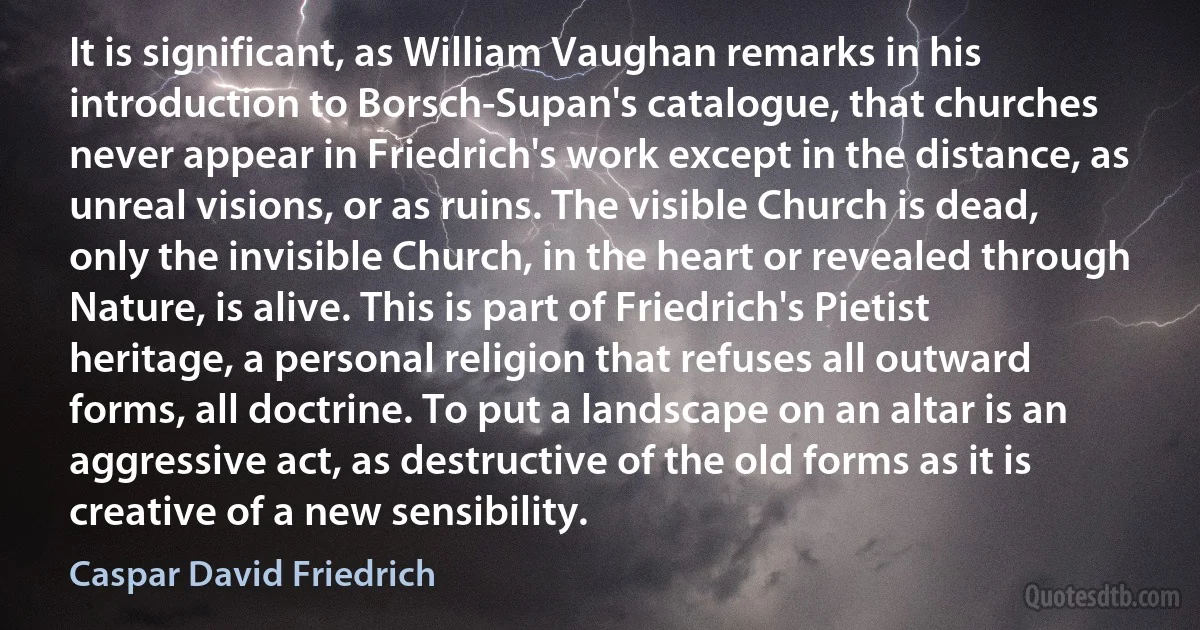
It is significant, as William Vaughan remarks in his introduction to Borsch-Supan's catalogue, that churches never appear in Friedrich's work except in the distance, as unreal visions, or as ruins. The visible Church is dead, only the invisible Church, in the heart or revealed through Nature, is alive. This is part of Friedrich's Pietist heritage, a personal religion that refuses all outward forms, all doctrine. To put a landscape on an altar is an aggressive act, as destructive of the old forms as it is creative of a new sensibility.
Caspar David FriedrichRelated topics
act appear catalogue church creative dead distance doctrine heart nature religion sensibility significant work williamRelated quotes
Do not do anything without signing yourself with the sign of the Cross! When you depart on a journey, when you begin your work, when you go to study, when you are alone, and when you are with other people, seal yourself with the Holy Cross on your forehead, your body, your chest, your heart, your lips, your eyes, your ears. All of you should be sealed with the sign of Christ's victory over hell. Then you will no longer be afraid of charms, evil spirits, or sorcery, because these are dissolved by the power of the Cross like wax before fire and like dust before the wind.

Cleopa Ilie
The destructive work of totalitarian machinery, whether or not this word is used, is usually supported by a special kind of primitive social philosophy. It proclaims not only that the common good of 'society' has priority over the interests of individuals, but that the very existence of individuals as persons is reducible to the existence of the social 'whole'; in other words, personal existence is, in a strange sense, unreal. This is a convenient foundation for any ideology of slavery.

Leszek Kołakowski
Combativeness was, I suppose, the dominant trait in my grandmother's nature. An aggressive churchgoer, she was quite without Christian feeling; the mercy of the Lord Jesus had never entered her heart. Her piety was an act of war against the Protestant ascendancy [...] articles attacking birth control, divorce, mixed marriages, Darwin and secular education were her favourite reading. The teachings of the Church did not interest her, except as they were a rebuke to others [...] The extermination of Protestantism, rather than spiritual perfection, was the boon she prayed for.

Mary McCarthy
Even if some details of dogma aren't true-or even all of 'em-think what a consolation religion and the church are to weak humanity!"
"Are they? I wonder! Don't cheerful agnostics, who know they are going to die dead, worry much less than good Baptists, who worry lest their sons and cousins and sweethearts fail to get into the Baptist heaven-or what is even worse, who wonder if they may not have guessed wrong-if God may not be a Catholic, maybe, or a Mormon or Seventh-day Adventist instead of a Baptist, and then they'll go to hell themselves. Consolation? No!

Sinclair Lewis
The God of All Life was really more like a light than anything else, and the whole divine arena just lit up as if a universal spotlight was turned on from the inside of things, bathing every visible object. Everything Emir saw was lit up as if even the blades of grass had bulbs inside them, though bulbs hadn't been invented yet or spotlights either. Still, a new kind of superlight splashed out over the arena. More than this, the light itself was somehow kindly and alive, as if the God of All Life was everywhere at once, made of light, but with a presence inside that was invisible.

Robert Butts
